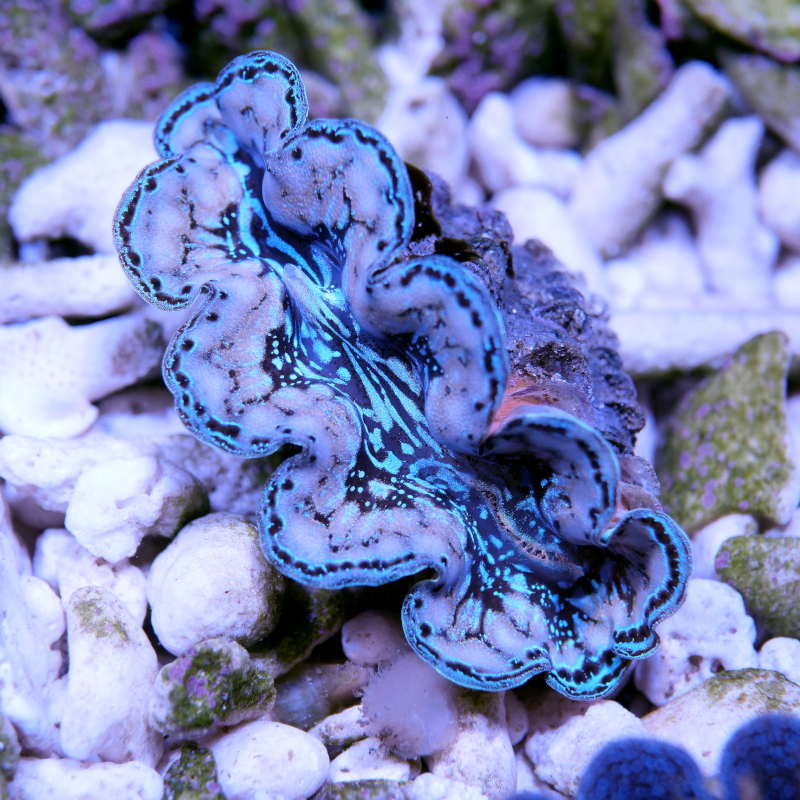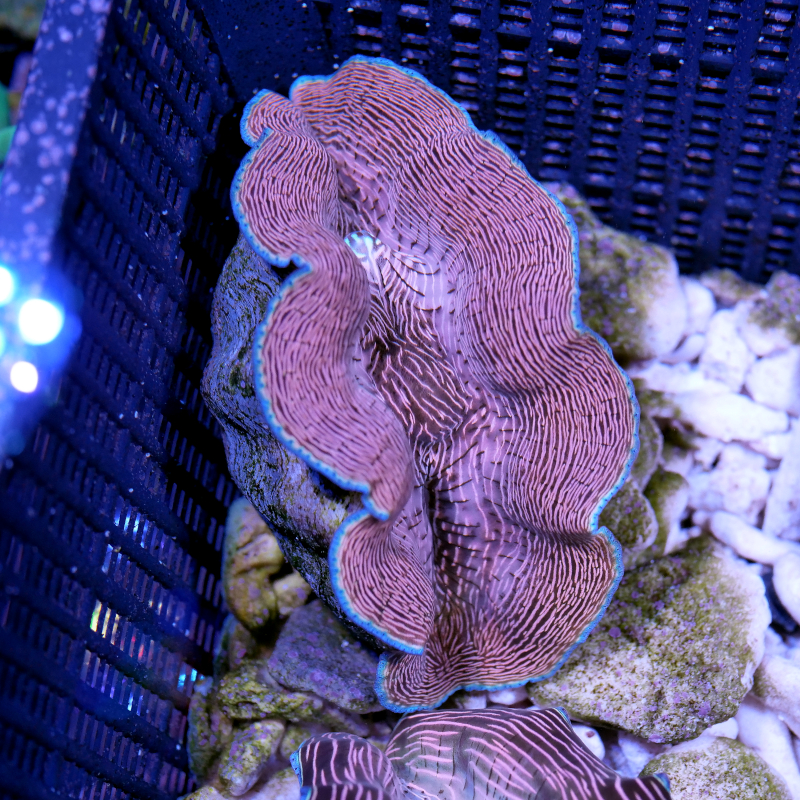TRIDACNA - KEEPING AND CARE OF GIANT CLAMS IN THE AQUARIUM

What is it that makes the Tridacna look so incredibly good?
The secret of their beauty is iridocytes, or in technical terms: iridocytes. This is the name given to the cells that are located in the mantle lobes of the Tridacna , contain guanine crystals and reflect incoming light. They give each mussel a unique appearance.
In addition to the glitter cells, there are numerous symbiotic algae in the mussel's tissue. They feed the Tridacna with metabolic products that arise during photosynthesis. The giant clams share this characteristic with corals. Both groups of animals are therefore fundamentally very similar in their requirements for keeping in an aquarium.
Place your Tridacna in a well-lit location in the aquarium and avoid shadows from reef structures or corals. Young mussels in particular can still be quite mobile and move around using one foot. Therefore, choose a location close to the ground so that the mussel cannot fall down and injure itself.
Tridacna mussels are naturally found mainly in shallow waters up to 15 m. A lighting spectrum similar to daylight is therefore the best choice for keeping them. If you use lighting with a high proportion of blue, pay particular attention to an adequate supply of nutrients. Limiting nitrates and phosphates while using intense blue lighting could otherwise cause unnecessary stress to your mussel.
As their shells grow, mussels can consume a considerable amount of calcium and magnesium. A stable calcium supply (e.g. Balling or All-For-Reef) is therefore essential for the well-being of your Tridacna .
Shell holder for Tridacna – yes or no?
Yes, because the weak point of a giant clam is on the underside: the byssal opening. Immediately behind it is the byssus gland. It produces strong threads that allow the clam to cling to the substrate. The byssal opening is a typical point of attack for bristle worms. Therefore, never place your Tridacna directly on the substrate or in the sand, but on a clam holder. The size of the byssal opening varies from species to species. It is largest in Tridacna crocea . This species should therefore definitely be placed on a clam holder.
Detach Tridacna from substrate
Tridacna mussels must never be removed from the substrate by force. Even a supposedly careful twisting can lead to the byssus gland being damaged or even torn out. Such actions usually inevitably lead to the death of the animals. If you absolutely have to remove a mussel from something, the only option is to carefully cut through the byssus threads with a sharp scalpel or razor blade.
Feeding Tridacna mussels – yes or no?
No, because Tridacna mussels with a shell length of around 4 cm or more do not need to be fed specifically. They get their energy almost exclusively from metabolic products of the symbiotic algae. It is therefore important to optimize the conditions for the symbiotic algae when it comes to nutrition. Strong lighting and a few dissolved nutrients in the water - a Tridacna doesn't really need much more than that. An exception are very young and small specimens whose mantle lobes are not yet large enough. These should be fed with very small phytoplankton such as Isochrysis . In general, be careful when giving dust food. In small mussels, this can lead to the internal organs sticking together.
Species within the group Tridacninae
Tridacninae comprises a total of 12 species divided into the genera Tridacna and Hippopus . Tridacna maxima and T. crocea are the most common species in the aquarium trade thanks to their attractiveness. But Hippopus hippopus , T. squamosa and T. derasa can also occur in unique color patterns, albeit less frequently. The species can sometimes be distinguished from one another by their color pattern. However, a reliable identification is usually made based on the shell morphology (e.g. symmetrical/asymmetrical) or mantle characteristics (does it hang over the shell edge?; tentacles at the inlet opening?).

Extremely rare to find in the trade: Tridacna squamosa in blue
Which Tridacna is right for me?
The most important criterion when choosing a giant clam for your aquarium is the expected final size. Tridacna crocea, with a maximum size of 15 cm, is the youngest of the giant clams and is generally a good choice for aquarium keeping. In contrast, Tridacna gigas, with an expected final size of 140 cm and a growth rate of 8-12 cm per year, will not be suitable for most aquariums.
|
Type |
expected final size |
|
Tridacna crocea |
15cm |
|
Tridacna maxima |
25cm |
|
Tridacna squamosa |
40cm |
|
Hippopus hippopus |
40cm |
|
Tridacna sylvatica |
80cm |
|
Tridacna gigas |
140cm |

Tridacna derasa is by far the most demanding giant clam and should only be kept when water conditions are very stable .
Tridacna doesn’t open properly – why?
Disturbances caused by aiptasia, algae or neighboring corals are often a reason why giant clams do not fully extend their mantle flaps. A location with too strong a current or other reef inhabitants nibbling at the clam can also be the reason why the clam is often closed or only half open. Infestation by parasites or a disease cannot be ruled out either. You should definitely find the cause and change or eliminate it, otherwise the clam could die.
8 typical diseases and parasites in Tridacna and how you can fight them
#1 Shell snails
In particular, a member of the genus Turbonilla from the Pyramidellidae family, commonly known as the rice grain snail, can cause problems for Tridacna . The small white snails prefer to sit on the upper edge of the shell, under the mantle flap of the mussel, and suck from the animal's blood lymph. A small presence of these snails is not a problem. However, if the snail is able to reproduce unhindered, a severe infestation can be fatal for a Tridacna .
The best way to get rid of the snails is to repeatedly search and manually remove the little pests - especially at night. To ensure that the snails do not reproduce, you can connect a UV-C filter and increase the skimming. This removes the planktonic larval stages from the system. Juvenile wrasse of the species Coris gaimard are known as natural predators.
#2 Drilling sponges
Recognizable as a multitude of small, closely spaced holes filled with spongy tissue, drilling sponges can severely weaken giant clams. As a treatment, the affected areas should be dabbed with 1% formalin (outside the aquarium!), then rinsed with fresh water and the animal then transferred to a quarantine tank.
#3 Tissue injuries caused by crabs or fish
All algae eaters in the aquarium can tend to become a problem for Tridacna - especially when there is no algae available. Among the crustaceans, these are mainly species from the groups Xanthidae, Portunidae and Dardanus . But some fish are also known to pluck at the mantle flaps of the Tridacna . Caution is particularly advised when keeping them with wrasse, pincer fish and rabbit fish. Even larger surgeonfish can develop an appetite for giant clams if no other algae are available.
As a preventative measure, you should always provide your algae-eating reef dwellers with enough food. As soon as you discover bite marks on the mussel, protect it from further attacks. To do this, cover it with a translucent grid or basket, or take the culprit out of the aquarium and give it to a fellow aquarist, for example.

Clearly visible bite marks on a Tridacna crocea . A rabbitfish is suspected. The mussels were then covered in baskets with coral rubble and light grid plates. After about 4 weeks the mantle had grown back.
#4 Bleaching
Just like corals, Tridacna can lose their symbiotic algae and become bleached, for example due to water temperatures that are too high or radiation intensity. While white corals can compensate for the lack of symbiotic algae through particulate nutrition and can recover from short-term bleaching, giant clams usually do not survive complete bleaching. If you notice that your clam is becoming extremely light, either place it in a less well-lit area or reduce the light intensity or the lighting duration.
#5 Bacterial infections
Young mussels are particularly at risk. Bacterial infections manifest themselves through tissue decay. Vibrio or Aeromonas species can be the cause. The best prevention is perfect tank hygiene (regular water changes, removal of sludge, etc.), thorough rinsing of all frozen food and UV-C filtration.
#6 Protozoan infections
Actually, only stressed animals are at risk of such an infection. Symptoms include a wide open inlet opening, incomplete opening of the mantle flap and whitish spots on the kidneys (not visible from the outside). Avoid such infections by reducing stress factors: ensure careful transport, optimal housing and use the drop method when transferring to a new tank.
#7 Cold damage
For Tridacna , short-term hypothermia is more critical than overheating. Water temperatures below 20 °C can have a negative effect. The animal then retracts its mantle flap and hardly reacts to light or touch stimuli. A water temperature between 24 and 26 °C is optimal.
#8 Heavy metal poisoning
Invertebrates such as Tridacna react particularly quickly and sensitively to poisoning by heavy metals. Symptoms include extreme lightening and a greatly expanded inlet opening. Causes can be corrosive objects (flow pumps, tweezers, blade cleaners...), contaminated additives (sea salt, drinking water...) or an overdose of trace elements. Here again, it is important to identify and remedy the cause as quickly as possible. A large water change, the use of activated carbon or the addition of Triton brand Detox also helps.
The most important things summarized again:
- Gently introduce the mussel to your aquarium using the droplet method
- Place them on a shell holder
- Provide strong lighting and a stable lime supply
- Never remove the mussel from the substrate by force
- Tridacna crocea and T. maxima are best suited for aquarium keeping
- Additional feeding is not necessary
- Avoid socialization with potential predators
- Keep activated carbon and a UV-C filter ready for emergencies







